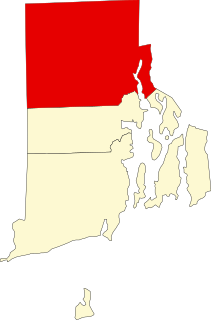
West Warwick is a town in Kent County, Rhode Island, United States. The population was 29,191 at the 2010 census.

The Greystone Mill Historic District encompasses an early 20th-century textile mill complex on Greystone Avenue in Johnston and North Providence, Rhode Island. The complex consists of three brick buildings on the North Providence side of the Woonasquatucket River, a dam spanning the river, and a water tank near the dam in Johnston. The main structure consists of a series of structures combined to form a rambling structure, built between 1904 and 1911 to designs by Frank Sheldon and Son, an architectural firm that was a leading designer of textile facilities at the time.

The Woonsocket Company Mill Complex is a historic district encompassing one of the largest mill complexes in Woonsocket, Rhode Island. The district includes all of the buildings historically associated with the Woonsocket Company, a major manufacturer of cotton textiles in the 19th century. The complex is located along the eastern bank of the Blackstone River between Court and Bernon Streets. It includes three handsome stone mills, built between 1827 and 1859, and a power plant that was built on the site of the former #3 mill between 1890 and 1920, as well as the remnants of the canal that originally carried water to the buildings for power.

The Dyerville Mill is an historic textile mill complex at 610 Manton Avenue in Providence, Rhode Island, USA. Its oldest buildings dating to 1835, it is one the oldest textile mill in the city. The complex is located between Manton Avenue and the Woonasquatucket River, just south of the Dyerville Mill Pond. Remnants of the head race run south from the pond, through the property, with the tail race exiting to the southwest. The main mill building is a 3-1/2 story L-shaped stuccoed stone structure. The picker house is a 2-1/2 story stone structure southwest of the main mill, with a brick extension that also gives it an L shape and creates a courtyard with the main building. A 20th-century warehouse stands south of this complex. The mill was established by Elisha Dyer, father of Elisha Dyer and grandfather of Elisha Dyer, Jr., and was operated by the Dyer family until 1867. It was then operated by cotton broker Truman Beckwith and his son. The Joslin Manufacturing Company purchased the business in 1903 and operated textile production on the site until the 1930s. The site has thereafter seen other light industrial uses.

The Oriental Mills are a historic textile mill complex at 10 Admiral Street in Providence, Rhode Island. The site consists of seven buildings, constructed between about 1860 and 1917, by a variety of textile manufacturers that operated on the site. The oldest building, from c. 1860, was built by the Oriental Mills Manufacturing Company soon after its founding. It is a large three-story brick structure, presenting eight bays to Admiral Street and thirty to Whipple Street. It has a well-defined Italianate roof line with brackets. Building 3, which lies southeast of Building 1 and fronts on Oriental Street, is from the same time period and exhibits similar styling. Originally used for the manufacture of cotton textiles, the complex was purchased in 1918 by the American Silk Spinning Company, which pioneered the blending of nylon fibers into its products here.

Providence Dyeing, Bleaching, Calendring Company is an historic industrial complex located at 46,50,52,60 Valley Street and 80 Delaine Street in Providence, Rhode Island. It consists of 18 small-to-medium-sized brick and stone structures in a parcel 4 acres (1.6 ha) in size, between Valley Street and the Woonasquatucket River. Although most of these buildings were constructed between 1900 and 1920, the oldest building in the complex is a single-story rubble stone structure which may contain elements of an 18th-century mill structure, and is known to have achieved its present form around 1837. The original water privilege for this mill site was granted to Christopher Olney in 1773 for a paper mill.

The Upper Rockville Mill is an historic mill complex at 332 Canonchet Road in Hopkinton, Rhode Island. The complex occupies about 0.5 acres (0.20 ha) of land, and includes two buildings, the site of a third, and their associated waterworks, including Wincheck Pond and surviving raceway elements. The two buildings are the main mill building, a 3-1/2 story stone structure built 1844-45, and a two-story auxiliary building added in the 1860s. The Rockville Manufacturing Company, which operated the mill, was a major employer and landowner in the area for much of the 19th century. The property was operated by a variety of textile concerns until 1953, when the property was briefly owned by the Boy Scouts of America (BSA), whose Camp Yawgoog, located on the shores of Wincheck and Yawgoog Ponds, was affected by the mill's water rights. The BSA retained the water rights and sold off the rest of the property.

The Crompton Mill Historic District is a historic district encompassing a mill complex at 20 Remington Street, 53 and 65 Manchester Street in West Warwick, Rhode Island. The mill complex consists of a collection of mainly brick buildings, bounded by the Pawtuxet River and Pulaski, Remington, and Manchester Streets in the village of Crompton. The mill complex formerly extended across the river, but the complex on the west bank was destroyed by fire in 1992. The oldest elements of the complex are the dam site and some of the raceways that provided water power to the mills. The present dam was built in 1908, replacing an 1882 structure. The raceways were built in 1807, around the time of the first mill buildings. The stone Mill No. 1, built 1807, is believed to be the oldest stone mill building in the state. Most of the complex's buildings were built in the late 19th and early 20th centuries by the Providence Manufacturing Company and its successors. The mill was used for textile processing until 1946, when the Crompton Corporation ended production.
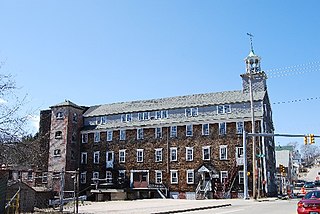
The Lippitt Mill is an historic mill at 825 Main Street in West Warwick, Rhode Island.
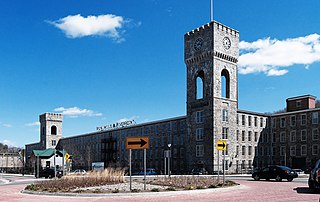
The Royal Mill Complex is an historic textile mill site at 125 Providence Street in West Warwick, Rhode Island. The mill complex was listed on the National Register of Historic Places in 2004. It has recently been completely renovated and remodeled into 250 residential apartments. The complex also includes the Ace Dye Works mill on the south side of the river, which has been converted into lofts. A pedestrian skybridge connects the two mills.

The Church Hill Industrial District is an industrial historic district on the west side of Pawtucket, Rhode Island. It encompasses an area that was intensively developed between about 1850 and 1920, and includes five separate industrial facilities. Four of these are relatively modest in size, and originally served a combination of textile mills and ironworks, the latter of which often manufactured parts used in the textile manufacturing processes. The oldest building is an 1848 ironworks facility, which runs along Pine Street between Main and Bayley. The largest single complex, added in the 2011 expansion of the district, is the Union Waddell complex between Bayley Street and the Amtrak railroad tracks, which has ten surviving buildings from the early 20th century.

The Jules Desurmont Worsted Company Mill is a historic mill at 84 Fairmount Street in Woonsocket, Rhode Island. The mill complex consists of three brick buildings, erected 1907-10 by Jules Desurmont, the owner of a textile firm in Tourcoing, a city in northern France, who had been drawn to Woonsocket by the promotional activities of Aram Pothier. The mill produced French worsted wool yarn until 1952, and was used for many years thereafter by smaller textile and industrial concerns.

Lippitt, Rhode Island is a village within the town of West Warwick, Rhode Island.
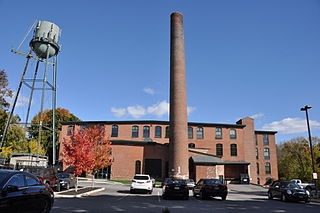
The Pocasset Worsted Company Mill is an historic industrial complex at 75 Pocasset Street in Johnston, Rhode Island. It consists of a complex of four connected brick buildings, built between 1897 and 1902. The buildings form a rough U shape on a 3.38 acres (1.37 ha) parcel of land between Pocasset Street and the Pocasset River. The two legs of the U are nearly identical main mill buildings, constructed in 1897 and 1902; they are joined by an engine and boiler house. The mill office building is attached to the southern (1897) mill building. The Pocasset Worsted Company was Johnston's largest employer in the early 20th century; its buildings were used for textile production until 1989.
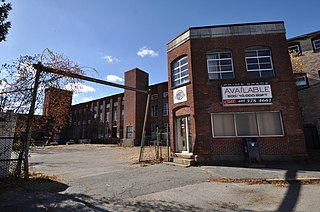
The Lymansville Company Mill is a historic industrial complex at 184 Woonasquatucket Avenue in North Providence, Rhode Island. The oldest portion of the complex, a three-story brick building which originally a textile spinning and carding building, was built in 1884. The mill was significantly expanded in subsequent years, with its last addition taking place in 1951. The Lymansville Company was founded in 1884 and closed in 1957. Auguste Albert Sack, the leading partner in the company, was a German immigrant with significant work experience in New England's textile industry.
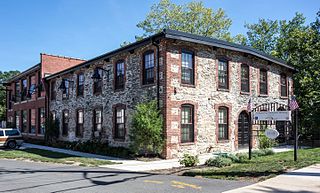
The Heaton and Cowing Mill is a historic industrial facility at 1115 Douglas Avenue in Providence, Rhode Island. The small mill complex consists of three connected building sections; the oldest is a c. 1832 rubble-walled two story mill building constructed by David Heaton and Martin Cowing on the banks of the West River. The partners used the facility to manufacture and dye cotton cloth. The building is the remnant of a much larger Geneva Worsted Company works that Heaton and Cowing built on the site in the 1860s and 1870s. The building was used, with a major brick addition c. 1930, for textile production until the 1950s, until its last textile owner, the Wanskuck Mill, shut down. It served a variety of light industrial businesses, and in 1982 a concrete block building was added to its rear. Most of its original waterworks infrastructure has either been filled in, or was destroyed by flooding in 2010.
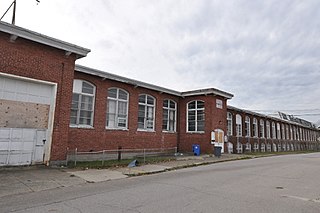
The Naushon Company Plant is a historic textile mill complex at 32 Meeting Street in Cumberland, Rhode Island. First built in 1902-04 and enlarged over time, it illustrates the adaption of the site to differing uses between then and the 1950s, when its use for textile manufacture ended. The complex was listed on the National Register of Historic Places in 1978.

The Jenckes Spinning Company is a historic textile factory complex in Pawtucket, Rhode Island. Located on Conant and Weeden Streets, the complex was developed between 1883 and 1919, and was home to the city's largest employer in the 1910s, producing cotton fabric and fabric for use in automotive tires until 1933. The factory complex was listed on the National Register of Historic Places in 2018.

The Andrews Mill Company Plant is a historic industrial complex at 761 Great Road in North Smithfield, Rhode Island. Built beginning in 1918, it was home to a maker of French worsted wool textiles, part of a major industrial development push in northern Rhode Island at the time. The complex was listed on the National Register of Historic Places in 2018.






